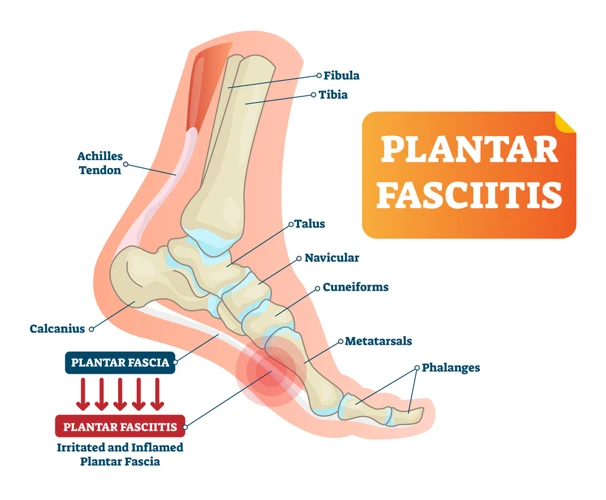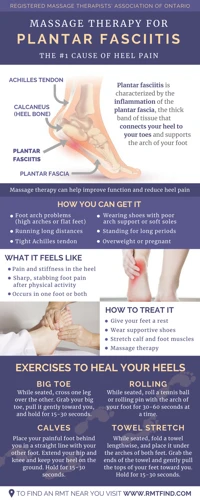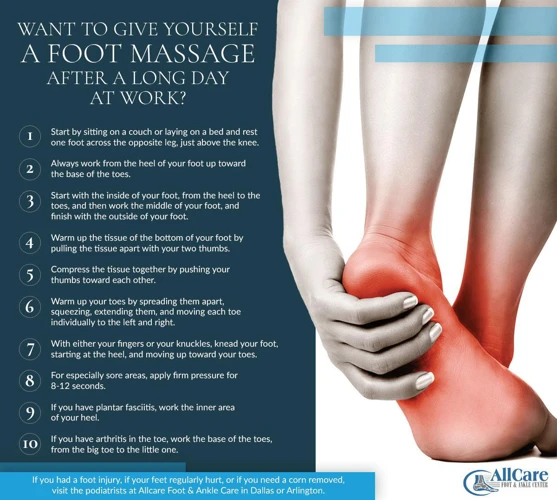If you are suffering from plantar fasciitis, a common form of heel pain, then you may be looking for ways to massage the area to relieve some of the pain. Massaging the area can help reduce inflammation and break down scar tissue, making it easier to stretch, exercise and walk without pain. In this article, we will discuss how to massage plantar fasciitis, including simple techniques to help ease your foot pain.
Contents
What is Plantar Fasciitis?

Plantar fasciitis is a common condition that occurs when the thick band of tissue on the bottom of the foot, known as the plantar fascia, becomes inflamed and irritated. The plantar fascia is a ligament that connects the heel bone to the toes and helps the foot with flexibility and movement. When the plantar fascia is overworked, it can become damaged and cause pain and inflammation. This can lead to heel pain, especially when standing or walking.
Pain associated with plantar fasciitis can range from mild to severe and can be worse in the morning or after sitting for long periods of time. Other symptoms may include swelling, stiffness, and tenderness in the heel area.
If you are experiencing persistent heel pain, it is important to seek treatment from a healthcare professional. Massage therapy is one treatment option that may help to relieve the pain and discomfort associated with plantar fasciitis. Here are some simple techniques for how to massage foot for plantar fasciitis.
Techniques for How to Massage Foot for Plantar Fasciitis:
- Friction Massage: Applying deep pressure with the thumb and fingers to the affected area in slow, circular motions.
- Cross-Fiber Friction: Applying similar pressure to the affected area, but in a perpendicular direction to the fibers of the plantar fascia.
- Trigger Point Massage: Applying deep pressure to specific points in the affected area to release tension.
- Myofascial Release: Using sustained pressure to help release tension in the fascia.
- Stretching: Gently stretching the calf muscles, Achilles tendon, and plantar fascia to help relieve tension.
Massaging Techniques for Plantar Fasciitis

Massaging the Heel
To massage your heel for plantar fasciitis, start by placing your thumb on the heel and your fingers on the bottom of the foot. Apply firm pressure and use a circular motion to massage the heel. Start at the back of the heel and move up towards the Achilles tendon. Continue this massage for 2-3 minutes.
Massaging the Arch of the Foot
To massage the arch of the foot, place your thumb on the arch and your fingers on the bottom of the foot. Apply firm pressure and use a circular motion to massage the arch. Start at the back of the heel and move up towards the toes. Continue this massage for 2-3 minutes.
Massaging Other Areas of the Foot
To massage other areas of the foot, use your thumb to apply firm pressure to the top and bottom of the foot. Work your way up from the heel to the toes, using circular and kneading motions to massage the foot. Continue this massage for 2-3 minutes.
By taking the time to massage your feet, you can help to alleviate the pain and discomfort associated with plantar fasciitis. Massaging the heel, arch, and other areas of the foot can help to reduce inflammation and improve circulation in the feet. Additionally, regular massage can help to stretch and strengthen the muscles and tendons in the feet, further reducing the pain and discomfort caused by plantar fasciitis.
Benefits of Massaging Plantar Fasciitis

Massage therapy is a powerful tool for relieving heel pain from plantar fasciitis. It can help to:
- Reduce pain and inflammation.
- Increase flexibility and mobility.
- Improve circulation for healing.
- Stimulate the release of endorphins for pain management.
- Promote relaxation and reduce stress.
- Help break up scar tissue.
Massage can also be used to complement other treatment methods such as stretching and strengthening exercises, orthotic devices, and rest. It can be used to target specific areas of the foot and ankle to help relieve pain and improve mobility.
When to Seek Professional Help

If home treatments are not helping to relieve the pain of plantar fasciitis, or if the pain is severe, it is important to seek professional help. A doctor or physiotherapist can help diagnose the condition and provide advice on the best course of treatment. They may suggest medication to help manage the pain and inflammation, or advise on the use of orthotic devices such as heel cups, splints or insoles. It may also be beneficial to receive therapeutic massage from a qualified massage therapist, as this can help to reduce pain, inflammation and improve flexibility. Massage techniques such as friction, kneading and cross-fiber friction can be used to target the plantar fascia and help reduce the pain of plantar fasciitis.
It is important to seek professional help if home treatments fail to relieve the pain of plantar fasciitis. A doctor or physiotherapist can provide advice on the best course of treatment, and a qualified massage therapist can provide therapeutic massage to target the plantar fascia and help reduce the pain.
Safety Considerations
Always use caution when massaging. Make sure to avoid any areas that are especially tender and keep the massage light and gentle. Do not press too hard as this can cause more pain and inflammation. Also, be aware of any existing medical conditions that could be aggravated by massage.
Be sure to wash your hands. Proper hygiene is essential to preventing the spread of germs and bacteria.
Choose an appropriate massage oil. Select a massage oil that is specifically designed for the feet and has ingredients that will not cause irritation.
Be aware of any allergies. Make sure that the person receiving the massage does not have any allergies to the massage oil or any of the ingredients.
Don’t massage too frequently. Massaging the plantar fascia too often can lead to further irritation and inflammation. It is best to massage the area no more than once or twice a week.
Stay away from broken skin. Avoid massaging any areas that have cuts, scrapes, or open sores.
Consult a doctor. If the pain persists or worsens, consult a doctor to rule out any underlying medical conditions.
Frequently Asked Questions
How Often Should I Massage My Feet to Alleviate Plantar Fasciitis?
Daily: Massaging the feet daily can help reduce inflammation and pain associated with plantar fasciitis.
Frequency: Massage your feet two to three times a day, for 5-10 minutes each session.
Time: Massage your feet in the morning before getting out of bed and at night before going to bed.
Technique: Use a tennis ball or a massage roller to massage the bottom of your foot from heel to toe.
Benefits: Massaging your feet can improve joint flexibility, reduce inflammation and pain, and promote healing.
Tip: Make sure to keep your feet warm and well-hydrated to maximize the benefits of the massage.
Is it safe to massage my feet if I have diabetes?
It is generally safe to massage your feet if you have diabetes, however, there are a few things to keep in mind. Firstly, be sure to check your feet for any wounds or sores before massaging them. Additionally, make sure to massage gently and avoid applying too much pressure. If you experience any pain or discomfort, stop the massage immediately and contact your healthcare provider.
How Long Should I Massage My Feet When Treating Plantar Fasciitis?
Massage Duration:
- Start with a light massage lasting a few minutes and gradually increase the time.
- For best results, massage your feet for 5-10 minutes, 3-4 times a day.
- For severe pain, massage for 10-15 minutes, 4-5 times a day.
Other Considerations:
- If you experience any pain or discomfort, reduce the duration or intensity of the massage.
- It is important to listen to your body and adjust the massage accordingly.
- Be sure to drink plenty of water after a massage to help flush out toxins.
What activities should I avoid while massaging my feet to prevent further injury?
- Avoid intense, deep massage: Deep tissue massage can be too intense and should be avoided when massaging the feet. It can cause further inflammation and pain.
- Do not stretch excessively: Stretching too much can cause further injury. Only perform gentle stretches and hold them for just a few seconds.
- Do not put pressure on areas of pain: It is important to avoid putting pressure on areas of pain and discomfort. This can lead to further injury and should be avoided.
- Do not massage for too long: Massaging for too long can cause soreness and further inflammation. It is important to limit the time spent massaging the feet to just a few minutes.
Should I use lotion or oil when massaging my feet?
Using lotion or oil when massaging the feet can help reduce friction, allowing the massage to be more effective. Oils can be used to reduce tension and stiffness in the feet, while lotions can help to moisturize and relax the skin. Depending on your preferences and the condition of your feet, either oil or lotion can be used.
Conclusion
Massaging the plantar fascia can be a very effective way to reduce pain and prevent further damage in the feet. It is important to be gentle and not apply too much pressure when massaging the plantar fascia. Additionally, it is beneficial to combine massaging with other treatments such as stretching, icing, and using supportive shoes. With the right technique, massage can be a simple and effective way to relieve pain and prevent further damage in the feet.

